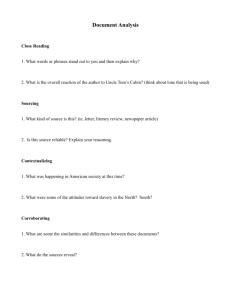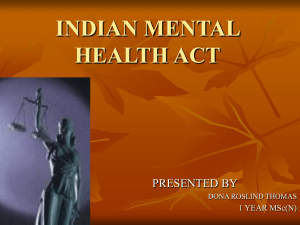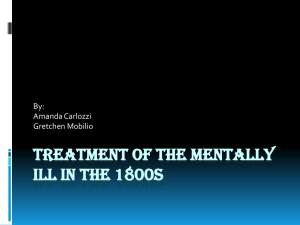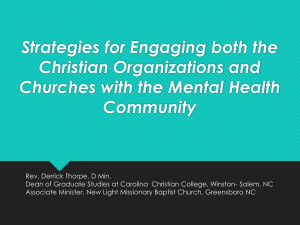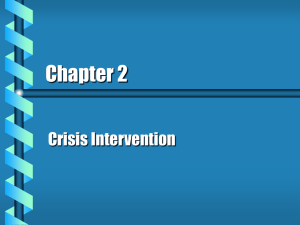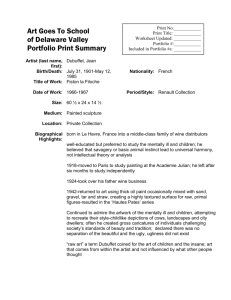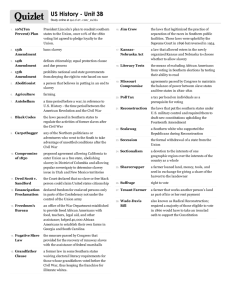Chapter 18 Vocab
advertisement
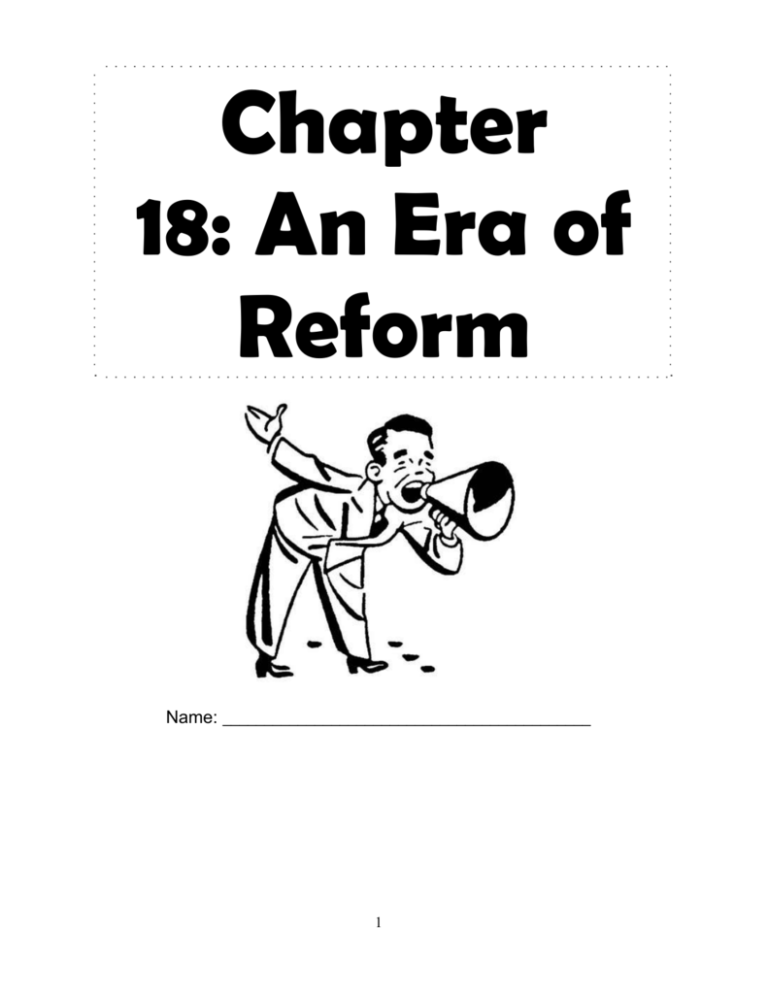
Chapter 18: An Era of Reform Name: ____________________________________________ 1 Chapter 18 Vocab abolitionists—people who favored abolition, the ending of slavery Declaration of Sentiments—a formal statement of injustices suffered by women, written by the organizers of the Seneca Falls Convention public schools—schools paid for by taxes & managed by local government for the benefit of the general public reformers—people who work to correct failings or injustices Second Great Awakening—a revival of religious feeling & belief in the 1820s & 1830s; people started to believe that doing good things on Earth would secure them a place in heaven after life Chapter 18 Important People Frederick Douglass— believed African Americans should enjoy the same rights as white people Elizabeth Cady Stanton— biggest women's rights activist; wrote the Declaration of Sentiments Lucretia Mott— worked with Stanton at the Seneca Falls Convention to fight for women's rights Dorothea Dix— fought for better treatment of the mentally ill Soujourner Truth— former slave who gave speeches throughout the North against slavery & for women's rights Elizabeth Blackwell— graduated as the country's first female doctor & advocated for women's rights 2 Movement & People Involved Restatement of the Problem or Issue Changes Made The Second Great Awakening Christian ministers said People (groups) involved: people didn’t have control over their fates. Christians Therefore there was little reason to perform good deeds. Crime & Punishment People Involved: Calvinists, Congregationalists, & Presbyterians Early 1800s, preachers began telling followers that everyone could gain forgiveness…one way was to do good works for others. public whipping, placement in individual cells in jail; public stocks or branding, prisoners worked in large, execution; punishment open workshops should be swift, punitive, & of little cost to the public; prisoners were chained with leg irons Crusade for the Mentally Ill nobody understood the People Involved: Dorothea mentally ill so they were treated harshly & unfairly made asylums with clean environments outside of major cities; they put them in hospitals instead of prisons Dix 3 Historical Comprehension & Interpretation What were the effects of the 2nd Great Awakening? Gave both men and women a reason to work to improve society. Which of the Bill of Rights amendments did many punishments conflict with & why? 8th amendment should have protected inmates from cruel & unusual punishment Label each with or cage for the mentally ill ____ hospital to replace prison _____ chair to “calm” patients _ spinning contraption to “balance” mental problems _____ restraints for mentally ill ____ Historical Comprehension & Interpretation Movement & People Involved Restatement of the Problem or Issue Education in America People Involved: Christians & Horace Mann students had to pay a nominal tuition; expected students to know how to read before attending school; few textbooks; put together in huge class regardless of age Sunday school; teachers received training; statewide curriculum; schools funded through property taxes; mostly European boys attended free public schools What are three reforms to education that affect how you go to school today? Trained teachers, grades for age & skill levels, statewide curriculum Fighting Slavery People Involved: Africans were enslaved against their will. Abolitionists helped change the northerners’ attitudes toward slavery. Frederick Douglas started a newspaper called? Helped pave the way for the struggle for women’s rights. What was the newspaper’s motto? Changes Made Frederick Douglass William Lloyd Garrison Sojourner Truth North Star Right is of no sex-Truth is of no color Who would read this newspaper? Ex- abolitionist Who would not read this newspaper? Ex- plantation owner 4 Movement & People Involved Restatement of the Problem or Issue Changes Made Historical Comprehension & Interpretation Women’s Rights People Involved: Catherine Beecher, Sarah J. Hale, Elizabeth Cady Stanton, Susan B. Anthony women could not vote in local, state, or national elections, nor could they qualify to hold public office; some jobs were closed to women opportunities for education became more available; more jobs available; men & women became viewed as equal What were some of the more important inequalities which women campaigned against? Being unable to vote, having no legal status apart from their husbands, couldn’t own land Seneca Falls/Right to Vote People Involved: Cady Stanton Lucretia Mott Women did not have equal rights in the United States Created an organized campaign for women’s rights The S.F. Declaration of Sentiments was modeled after what important document? Declaration of Independence List 3 advances achieved at the S.F. Convention: NY gave women control over property/wages Mass. & Indiana passed more liberal divorce laws Blackwell started her own hospital Women were eventually given the right to vote 5 Chapter 18: An Era of Reform Across 3. former slave who gave speeches throughout the North against slavery & for women’s rights 7. a revival of religious feeling and belief in the 1820s & 1830s 9. reformer of prisons and treatment of the mentally ill 10. people who work to correct failings or injustices 12. graduated as the country’s first female doctor, but no males would agree to work with her 13. argued that black men & women should have the right to vote, & so should all women 14. encouraged to write a speech for Oberlin College, but not permitted to speak in public 6 15. a formal statement of the injustices suffered by women 16. thought that aiming for women’s right to vote was not realistic 17. William Lloyd Garrison’s fiery abolitionist newspaper 18. the conference for the women’s rights movement, taking place in New York Down 1. wanted to give slaveholders time to develop farming methods that didn’t rely on slave labor 2. schools that are paid for by taxes and managed by local government for the benefit of the general public 4. reformer of education who spoke out for better public schools 5. tried to inspire slaves to rise up in revolt 6. a mental institution which took care of people declared “insane” 8. sisters who had formerly owned slaves, but spoke out about the pain of slavery 11. a person who favored the ending of slavery Follow the directions to complete the item below. Choose one of the following topics from Chapter 18: abolition movement education reform prison reform/treatment of the mentally ill women’s rights movement After choosing your topic, select one of the reformers that played a key role in changing the conditions for that group of people. Write a letter to this person to tell them about their lasting impact, which should include the following information: what conditions were like for this group of people before this reformer got involved (3+ facts) how this reformer made a difference (2-3 specific ways) what conditions are like for this group of people today (2+ facts) Dear _________________________________________, __________________________________________________________________________________ ________________________________________________________________________________________ ________________________________________________________________________________________ ________________________________________________________________________________________ ________________________________________________________________________________________ ________________________________________________________________________________________ ________________________________________________________________________________________ ________________________________________________________________________________________ ________________________________________________________________________________________ ________________________________________________________________________________________ ________________________________________________________________________________________ ________________________________________________________________________________________ Sincerely, ___________________________________ 7
